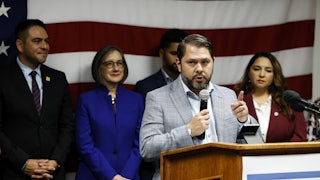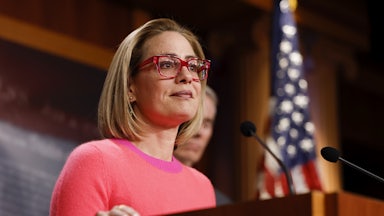Last Thursday, when Senator Kyrsten Sinema told Senate Majority Leader Chuck Schumer that she was leaving the Democratic Party and becoming an independent, she very deliberately made life more difficult for congressional Democrats. Her Senate colleagues, for starters. But maybe none more so than Congressman Ruben Gallego. That’s because for months the Arizona Democrat has been floating the possibility that he would challenge the Democratic senator in 2024, offering Arizona voters a less chaotic and unpredictable alternative to the incumbent senator, who is massively unpopular among her party’s rank and file.
But now, with Sinema running as an independent, the situation is more complicated. In the best-case scenario for Gallego, where he jumps into the Senate race and gets the nomination, he will likely have to fend off attacks from both Sinema, the first lawmaker to represent Arizona as a Democrat for 20 years, and a Republican candidate.
“It’s the most difficult calculus, I believe, because that’s the first principal effect of her decision, [to] create a much steeper hill for a Democrat,” said Chuck Coughlin, a veteran Arizona Republican political consultant. Coughlin added that “by virtue of her incumbency and her previous ’18 election, she’s going to have a swath of those centrist Democrats that will go her way. If you’re a Republican, what you’re really counting on is the Democrats eviscerating one another and taking a significant chunk of those centrist voters with them.”
The early indications are that Gallego is running. He has been interviewing campaign vendors and recently signed on a campaign pollster—a deliberate tell in Washington political circles that he plans to run for Senate next cycle. He’s been responding to questions about running with digressions as well. “We’re definitely getting support from national Democrats if I run. I’ve already spoken to a lot of national Democratic donors,” Gallego told Politico on Monday.
Still, the race will be tough. The next election cycle offers a daunting map with multiple Democratic senators up for reelection in states that strongly favor Republicans, Arizona included. Add to that that Democrats have only won in Arizona with strong support among their own electorate and self-identifying independents plus remarkably weak or extreme candidates put forward by Republicans.
For Gallego, that almost certainly won’t be the case this time around. In Washington, D.C., he’s carved out a name for himself as an outspoken left-leaning member of Congress with the right pedigree for elevation. He’s a Marine who fought in Iraq and also graduated from Harvard. In Arizona, though, he’s still just one member of Congress among nine, having never won statewide or really competed on that stage. Sinema has won statewide, and if the Republican is, for example, recent gubernatorial candidate Kari Lake, who just narrowly lost to Democrat Katie Hobbs, garnering 1.276 million votes, that would be a second candidate with high statewide name recognition.
He also may not be the only contender in the primary. Another member of the House, Congressman Greg Stanton, a former mayor of Phoenix, responded to Sinema’s switch by suggesting he might run competitively against Sinema in a 2024 Senate matchup.
Part of the profile Gallego has managed to build has been thanks to Sinema. Gallego has presented himself as a reliable Democratic vote and friend of the liberal wing of the party while, over the same period, Sinema has repeatedly bucked party leadership, watered down major policy items for the Biden administration, and fostered unusually cozy relationships with lobbyists and the larger business community. In the aftermath of the 2022 midterm elections, Sinema already has a war chest of over $7 million compared to Gallego’s roughly $1.1 million, according to the most recent Federal Election Commission filings.
The difficulties for Gallego, or really any Democrat, looking to help return Sinema’s seat to solid Democratic control go beyond that. While there have been musings among Senate Republicans about clearing a path for Sinema to stay in her seat, Arizona Republicans are more than likely to nominate their own candidate (even), and that candidate is likely to be a favorite of Donald Trump–loving conservative base voters. The types who are interested in purging moderates and only nominating the most right-wing candidates to statewide positions include Lake and Pinal County Sheriff Mark Lamb, who has backed the Stop the Steal campaign and sympathized with the January 6 rioters.
“Republicans [will] nominate a MAGA candidate. They [will] continue to do the stupid shit that they’ve been doing since ’18. So you got to count on that,” Coughlin said.
Beyond that, despite that for just a few days Arizona had two Democratic senators and an incoming Democratic governor for the first time in decades, the state is still an undeniable battleground state where Republicans have had the advantage. Both Republican and Democratic officials consider it a red-leaning state. When Democrats win in the state, it’s not by a landslide. In the last presidential election, Joe Biden beat Donald Trump in the state by a little more than 10,000 votes. That was the first time a Democrat won the state since 1996.
In the 2022 Arizona Senate race, Senator Mark Kelly, regarded by Republicans as one of the most formidable
candidates up for reelection that cycle, was reelected by just over 125,000
votes against an opponent who a Republican focus group found scored
the worst of any candidate in the history of focus groups conducted by that
super PAC. Kelly dominated among voters 29 and younger and fared well (58
percent to 37 percent) among voters between 30 and 44 years old. Blake Masters,
the Republican, led among voters 50 years and older, according to exit polling
data.
Kelly won 97 percent of voters who identify as Democrats, while Masters won 89 percent of voters who identify as Republicans. But Kelly won 55 percent of voters who identified as independents, while Masters won just 39 percent. A Sinema independent candidacy would likely woo away moderate Republicans, some conservative Democrats, and a fair number of independents.
Sinema is the first independent senator to represent Arizona, but she is not the first independent to run for Senate. In 2000, Senator Jon Kyl, the Republican incumbent, won a four-way race against William Toel, an independent who got 7.8 percent of the vote; Vance Hansen, the Green Party nominee, who also got 7.8 percent of the vote; and Barry Hess, the Libertarian nominee who got 5.1 percent of the vote. That was over 20 years ago, but the numbers indicate that Arizona does have a hefty percentage of voters who’ll consider spurning the major parties. Sinema, back before she was elected to Congress, was a member of the Green Party. The 2000 race may be indicative of what the situation could be in 2024 with all three of the major candidates winning more than single percentages of the voting electorate.
Turnout is likely to be high too in 2024. In the 2020 presidential race, over 3.3 million people voted for one of the two major party presidential nominees. In 2016, about two million people voted Hillary Clinton or Donald Trump, and Trump won with a little over one million votes. A high-profile Senate race plus a presidential race, possibly with Donald Trump once again as the Republican nominee, will dramatically juice turnout even more.
Multiple strategists I talked with for this story argued that under these conditions the only route for Gallego—or, again, any Democratic nominee—to take is to aggressively undercut Sinema early in a three-way race. One strategist actively working to beat Sinema now said the key would be to “turn her into a Republican.” That is, don’t allow Sinema to point too closely to her liberal victories, including helping to usher through legislation creating federal protections for gay marriage and also opting to support key climate provisions in the Biden administration’s domestic policy bill earlier this year.
“Republicans are going to call her a Biden liberal anyway. Democrats are going to call her something that is essentially ‘not a team player,’” said Sacha Haworth, a senior adviser for an anti-Sinema super PAC. “An untrustworthy seat, as we’ve seen in the Inflation Reduction Act negotiations, in the Build Back Better negotiations, and standing up for the filibuster instead of what her constituents want. She is not a reliable vote, nor is she a good-faith negotiator. Nobody knows what she thinks.”
If Gallego does run, he will need to maximize the Latino vote, replicate the support Kelly got among Democrats and independents, and hope Sinema largely steals support away from Republicans and doesn’t get too far with the state’s independents and Democratic moderates. That may prove tough—even as Sinema has shifted parties over the years, she has always identified as an independent voice for Arizona. In announcing her party switch, she maintained that she would be just as independent if not more. Now Sinema’s opponents are hoping that her time as a senator has shown she’s become far too independent from her constituents or her erstwhile political party. That sentiment has to stick for Gallego or any Democrat looking to win the 2024 Senate race.










